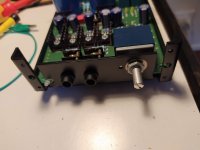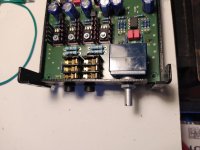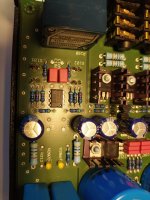I own an original Lehmann audio black cube linear that has recently started a hum issue.
I know this headphone amp has been cloned many times so am hoping someone familiar could help me troubleshoot.
The symptoms:
When I touch the volume knob I get hum. Both in the headphones and the line out
The hum is louder at high volume and worse when set to high gain settings
When I touch both the volume knob and a grounded part of the chassis such as the RCA connector the hum reduces or goes away.
It does not matter what amps/dacs are connected. The problem is persistent and only if I touch the volume knob.
Where do I start? What could cause this to start occurring after so many years?
Thank you for the assistance.
I know this headphone amp has been cloned many times so am hoping someone familiar could help me troubleshoot.
The symptoms:
When I touch the volume knob I get hum. Both in the headphones and the line out
The hum is louder at high volume and worse when set to high gain settings
When I touch both the volume knob and a grounded part of the chassis such as the RCA connector the hum reduces or goes away.
It does not matter what amps/dacs are connected. The problem is persistent and only if I touch the volume knob.
Where do I start? What could cause this to start occurring after so many years?
Thank you for the assistance.
Thanks Mark,
The washer that secures the pot to the front panel was loose.
I tightened it and it fixed the hum straight away. I exaggerated it in the pics.
I'm surprised because I've never taken this amp apart before.
Now the next question......
Since I have it open do I change the OPA2134 for a LM4562 that I have spare?
The washer that secures the pot to the front panel was loose.
I tightened it and it fixed the hum straight away. I exaggerated it in the pics.
I'm surprised because I've never taken this amp apart before.
Now the next question......
Since I have it open do I change the OPA2134 for a LM4562 that I have spare?
Attachments
The opamp is not really a bottleneck in this design, unless you find that you have audible output noise (would need very sensitive headphones). The limiting factor is the diamond buffer output stage being outside the feedback loop entirely.
Sounds you like you are familiar with the circuit.
What are the pros and cons of the buffer stage outside of the feedback loop vs inside?
The LM4562 is a very good opamp but some consider it to be a bit dry and clinical.
Too accurate you'd might say or even slightly 'thin' or without too much 'weight'.
This is in contrast to the more 'warm' and tube-like sound of the OPA2134.
Still, try the National opamp and you might like the change.
It all depends on personal preference.
However, I think the LM4562 will benefit from a better bypass capacitor scheme.
Another thing is to measure the DC ofsett before changing the opamps.
Meassure the DC ofseet with the OPA2134 and write it down.
Then do the same with the LM4562 and compare the figures.
You wan them to stay as low as possible.
Too accurate you'd might say or even slightly 'thin' or without too much 'weight'.
This is in contrast to the more 'warm' and tube-like sound of the OPA2134.
Still, try the National opamp and you might like the change.
It all depends on personal preference.
However, I think the LM4562 will benefit from a better bypass capacitor scheme.
Another thing is to measure the DC ofsett before changing the opamps.
Meassure the DC ofseet with the OPA2134 and write it down.
Then do the same with the LM4562 and compare the figures.
You wan them to stay as low as possible.
Sounds you like you are familiar with the circuit.
What are the pros and cons of the buffer stage outside of the feedback loop vs inside?
In very simple words (maybe even oversimplified): Input stage which is opamp in this case has usually very low distortion but doesn't provide much output current. Output stage is opposite - high power but high distortion. By putting output stage in negative feedback loop of input stage you are getting best of two worlds. Feedback is correcting errors of output stage. Basically this means you are getting amplifier with performance of input stage and high power of output stage.
There are of course some trade offs. Nested feedback amplifiers are much harder to design and stabilize.
Similar idea to BCL but with nested feedback - Headphone Amplifier or even more reading Composite amplifiers - what's the story?
It's all in the ears of the beholder..Anyone who uses the phrase too accurate as a criticism is not able to think straight! I mean really...
I like the sound of it.
To be prescise, the sound of LME47920HA which is a metal can equivalent.
I like the LME47920HA enough, to use it in place of either the more expensive Muses01 or the very nice sounding OPA2134.
But as i wrote, it all depends on who is listening.
As-is, distortion performance into lower-impedance loads in particular is about 1-2 orders of magnitude higher than it could be (though largely frequency-independent at least). In return, stability should be almost unconditional.What are the pros and cons of the buffer stage outside of the feedback loop vs inside?
It seems likely that they would have tried it with global feedback at first but may have struggled to get things stable, so went with robustness instead. In simulation I found that circuits with two-stage, e.g. diamond, buffers tended to require much heavier compensation for good stability. It is no coincidence that circuits with global feedback tend to use single EF buffers (or very fast integrated diamond buffer circuits).
- Status
- This old topic is closed. If you want to reopen this topic, contact a moderator using the "Report Post" button.
- Home
- Amplifiers
- Headphone Systems
- Hum issues- Lehmann audio black cube linear


